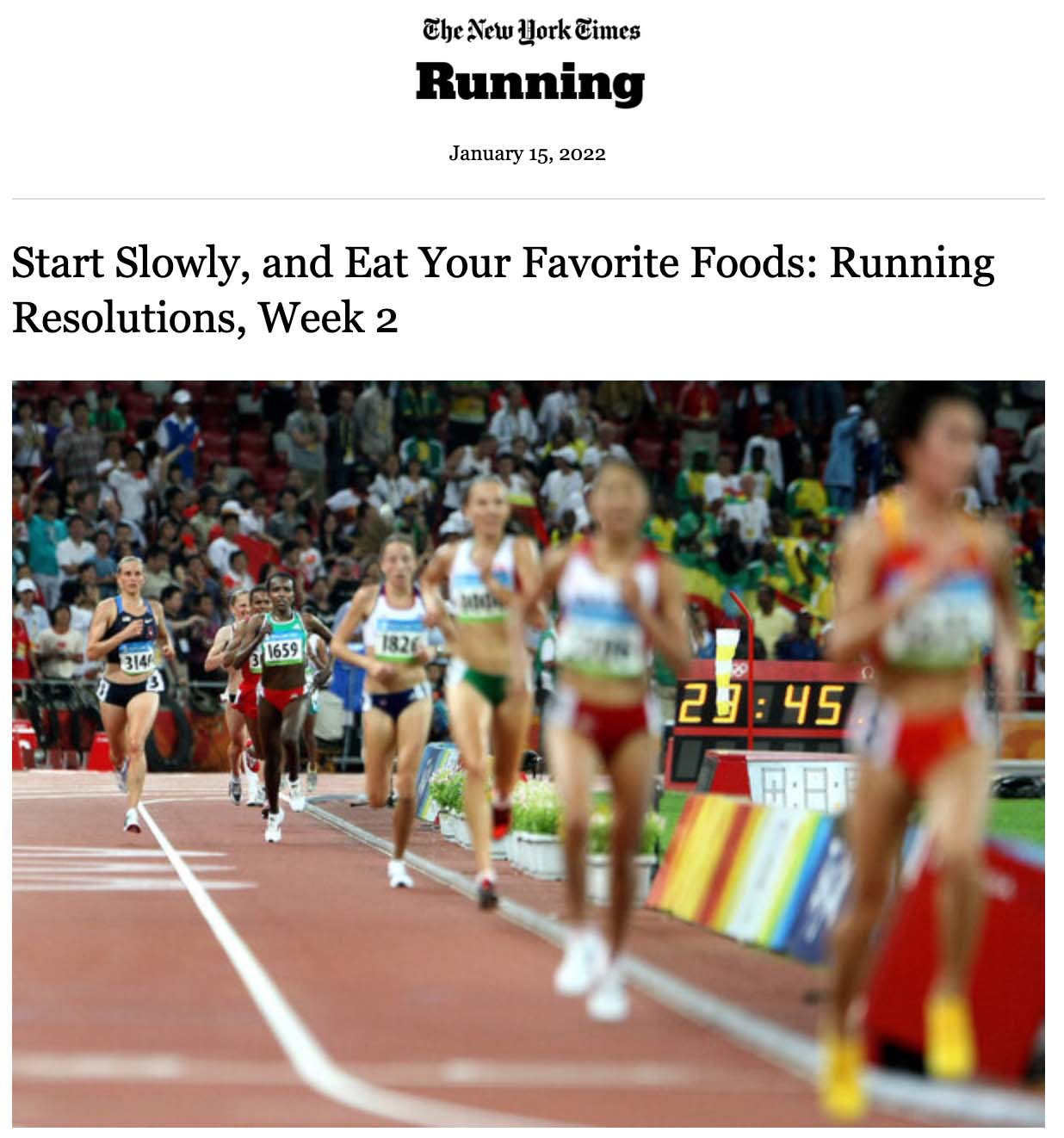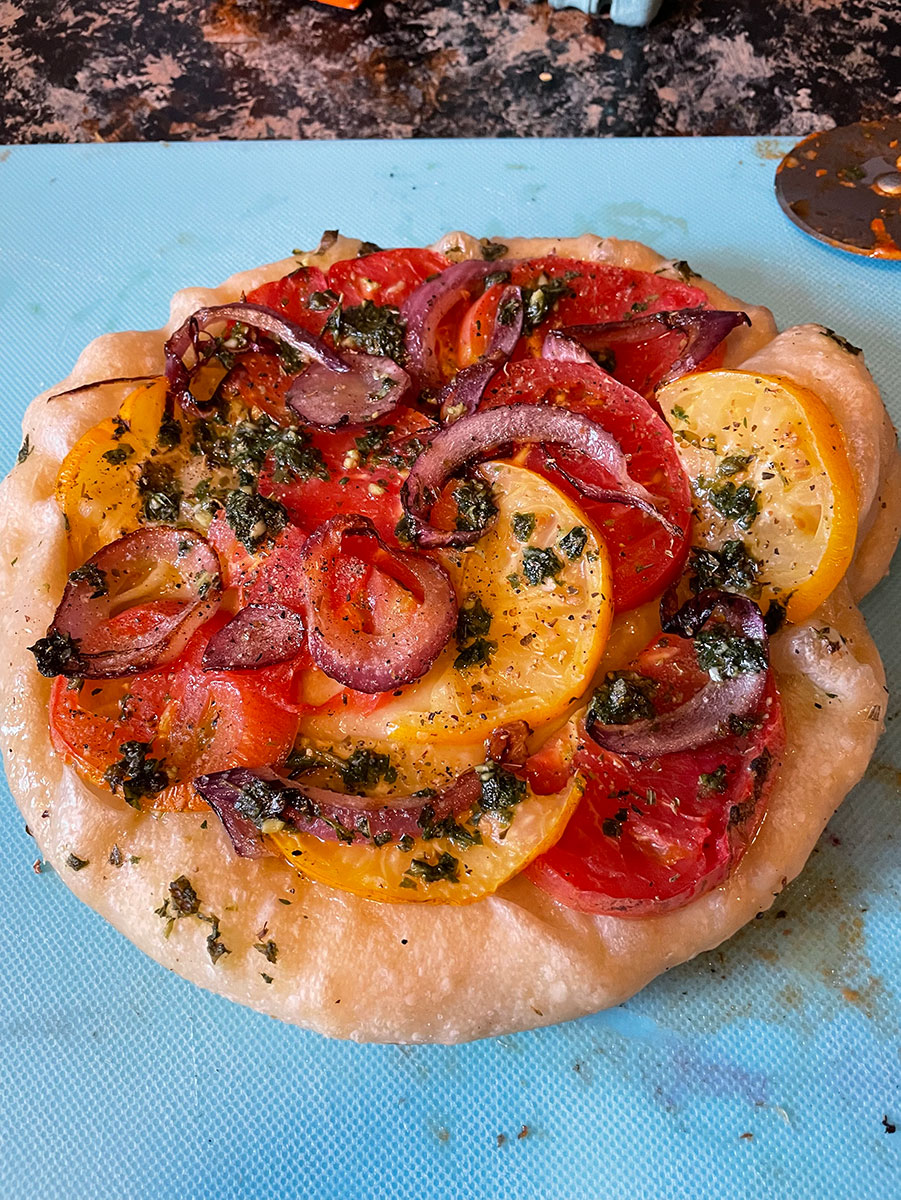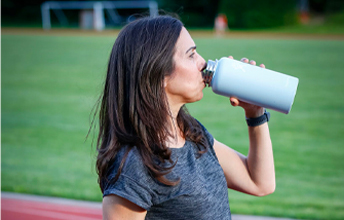Feature: Amy’s advice on how to fuel your running resolution
- Press
- January 15, 2022
Amy’s nutrition advice is featured in this NY times article on running resolutions. Click here for full NY Times article.
MS, RDN, CSSD, CEDS
Licensed dietitian
specializing in sports nutrition
and eating disorders
Amy’s nutrition advice is featured in this NY times article on running resolutions. Click here for full NY Times article.
Why important
It has been proven that athletes with more muscle mass and less fat are able to run faster due to the power-to-weight ratio. Oftentimes, athletes will try to lose weight in an unhealthy way which can negatively affect performance and cause injury. This post reviews safe and effective strategies to lower body fat without compromising performance and mental health.
Factors influencing body composition
Genetic predisposition, age, sex, activity level, and dieting history are a few factors that affect body composition. As we age, our bodies have a greater percentage of fat tissue although studies have recently shown that can be mitigated with healthy eating and exercise. Gender is also a factor, as male athletes tend to have lower body fat composition while female-identifying athletes tend to have higher body fat.

Off season
In the off season, many athletes find themselves increasing weight. Rather than crash dieting to get back into shape, I created a guide to help decrease body fat without losing muscle or compromising performance and may cause injuries to ensue.
Performance
Running performance is based on a power to weight ratio. Increasing the amount of muscle and decreasing body fat enable an athlete to move faster through strides with less effort.
Oftentimes, athletes will cut calories and “diet” or utilize intermittent fasting in an effort to lower body fat and improve performance. However, these types of diets lead to depletion of glycogen and muscle mass. They are overly restrictive and the athlete often ends up regaining the weight, mostly as fat tissue which decreases performance.
The human body needs a combination of carbohydrates, fats and protein to perform at its best. I’ve compiled a list of tips below to help athletes lose fat in a healthy way without feeling deprived, compromise performance or lead to weight regain.
Carbohydrates
During a run, our bodies are using glycogen, a stored form of glucose, as the primary source of fuel. Easy and tempo runs (VO2max 50-80%) utilize a combination of fat and glucose for fuel. Harder track workouts (VO2max >80%) will use mostly glucose. Since our bodies are mostly using glucose for energy, replenishment after a run with carbohydrate-rich food is essential to improve training and overall fitness. Studies have shown that carbohydrates are the fastest source of energy to power a workout or run. Carbs convert into glucose at a faster rate than protein or fats and enable the athlete to run and continue running at a faster speed. Target about 5-8 grams of carbohydrates per kilogram of body weight per day (Burke).
Protein
Protein-rich foods are essential to help replenish amino acids used by muscles and repair muscle damage that occurs during eccentric exercises such as down hill running. If the diet is lacking in protein, muscle repair and growth will be negatively affected. Target 1.5-2.3 grams of protein per kilogram of body weight per day (Mettler).
Fat
Fat provides calories to support hormone production, which helps regulate many important functions in the body such as; menstruation, bone formation, or iron regulation. It’s important to get in enough healthy fat calories to keep you full and provide fat soluble vitamins. Aim for 20% of calories from fat per day.
To convert pounds to kilograms, divide by 2.2.
All of these nutrients are critical to achieving optimal performance so careful attention needs to be made especially during weight loss efforts. Several studies have shown that crash diets don’t work and can lead to muscle loss, slow metabolism, poor mood, and decreased performance. To decrease body fat in a healthy way, follow these tips:
Tips
Learn more about intuitive eating. This is a concept that focuses on hunger and satiety cues. Reconnect with how your body feels when you are hungry. Learning to slow down when eating by chewing slowly and taking breaks will help you recognize when you are full. These simple strategies will prevent overeating.
Sample meal plan
Breakfast
Pre workout
Oatmeal w/ banana + nuts or nut butter
Post workout
Chocolate milk, granola bar or green smoothie
Lunch
Rice bowl with grilled chicken and vegetables
Bowl of strawberries
Or
PB&J with green smoothie – banana, ice, milk, peanut butter, and spinach
Snack
Plain low-fat yogurt with fruit
Dinner
Grilled chicken, salmon or turkey burger, baked potato, salad or steamed vegetables with olive oil and lemon
Dessert – blueberries or dark chocolate
Snack (optional)
Graham crackers and low-fat milk
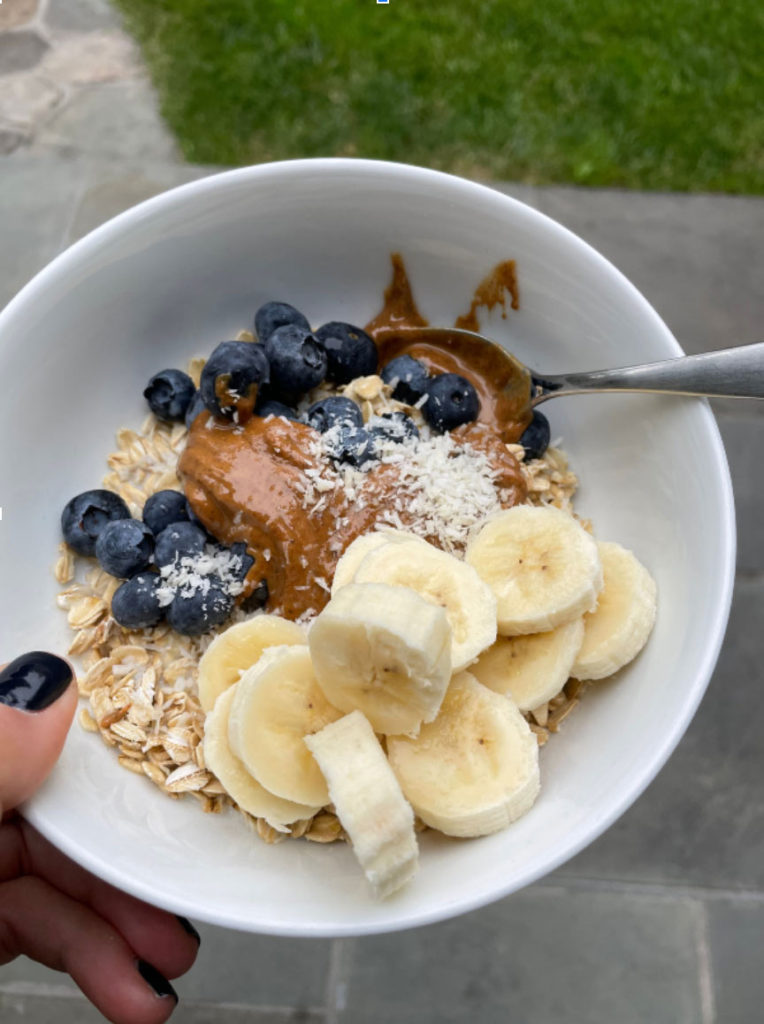
References
Burke L. and Deakin V. (2015). Clinical Sports Nutrition (5th edition). North Ryde, N.S.W McGraw-Hill Education.
Close GL, Sale C, Baar K, Bermon S. Nutrition for the Prevention and Treatment of Injuries in Track and Field Athletes. Int J Sport Nutr Exerc Metab. 2019 Mar 1;29(2):189-197.
Jeukendrup AE. Periodized Nutrition for Athletes. Sports Med. 2017 Mar;47(Suppl 1):51-63.
Mettler S, Mitchell N, Tipton KD. Increased protein intake reduces lean body mass loss during weight loss in athletes. Med Sci Sports Exerc. 2010 Feb;42(2):326-37.
Stellingwerff T, Maughan RJ, Burke LM. Nutrition for power sports: middle-distance running, track cycling, rowing, canoeing/kayaking, and swimming. J Sports Sci. 2011;29 Suppl 1:S79-89.
Thomas D, et al. Position of the Academy of Nutrition and Dietetics, Dietitians of Canada, and the American College of Sports Medicine: Nutrition and Athletic Performance. J Acad Nutr Diet. 2016 Mar;116(3):501-528.
Water is the forgotten nutrient
Exercise produces heat and leaves the body as sweat to stay cool. Studies have repeatedly shown that losing more than 2% body weight impacts performance (James). More sweat is produced when the temperatures are higher or when humidity is high. Dehydration results in an increase in one’s core temperature, reduced cardiovascular function and imparied exercise performance.
Essentially, dehydration increases an athlete’s perceived effort and reduces the ability to continue exercising at a high level (Nybo). If you’re overheating, the body will prioritize cooling itself versus rapid energy production (James).
Role of sweat
During exercise, the body produces heat and energy. Sweat is the body’s built-in cooling system that enables the body to make more energy. In warmer temperatures, exercise raises core temperatures at a faster rate which require more water expelled through the skin to keep the body cool. As temperatures increase, our bodies respond by sweating more. However, humidity compounds this problem by preventing evaporation. In situations where humidity levels are high, as we experience on the east coast all summer long, there is more moisture in the air and the sweat does not evaporate. As a result, the body’s core temperature increases, making exercise seem harder.

Dehydration affects performance
Many studies have shown that a 2% loss in body weight will impair performance (Lewis). The body has to work harder to keep the heart pumping to produce energy and muscles firing. Not only does it feel harder when you are dehydrated, but your body is also producing energy at a slower rate.
As core temperatures increase, energy metabolism shifts from aerobic production to anaerobic and this causes a buildup of anaerobic by-products that stimulate fatigue. This process occurs at a faster rate in hot and humid conditions. Fuel source shifts from fatty acids to glucose and amino acids and creates more hydrogen and lactic acid (Burke 2015). The heart receives less blood and therefore, less oxygen is delivered to working muscles. This makes exercising even more difficult in warmer conditions. Muscles have a harder time contracting when they’re overheated and premature fatigue can set in (Nybo).
Cramping
If you lose too much water, the risk of cramping is increased. Humidity increases risk of dehydration which causes an imbalance of electrolytes, especially potassium, magnesium and sodium. These electrolytes are lost at high levels through the skin and have a significant impact on cramping (Jung).
Symptoms of dehydration
Dietary recommendations in the heat
Fluid requirements are individualized. Establish your sweat rate by using a sweat test to better estimate the amount of sweat you lose in one hour of exercise. Once you know how much fluid your body loses, you can more precisely match your fluid requirements. Estimate fluid losses by using a sweat rate calculator to input your weight and fluids. Calories do not need to be increased when exercising in heat (Burke).
Hyponatremia is caused by drinking too much water and not enough electrolytes. Make sure to have salt or nuun tablets handy. Water follows electrolytes and when you sweat, you lose both!
The color of your urine is the best indicator of hydration. Aim for pale yellow, shade 1 or 2 on the chart is ideal. Clear urine can indicate fluid overload and hyponatremia. If your urine is dark yellow before a run, delay the start until you can drink more fluids.
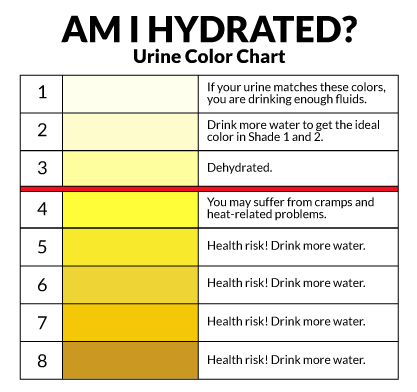
References
Baker & Jeukendrup. Optimal composition of fluid replacement beverages. Comp Physiol. 2014;4:575-620.
Burke L. Nutritional needs for exercise in the heat. Comp Biochem Physiol Mol Integr Physiol. 2001; 128: 735-48.
Burke L. Clinical Sports Nutrition, 5th edition. 2015.
Cory M, et al. Resistance training in the heat improves strength in professional rugby athletes. Sci Med in Football. 2019;3:198–204.
James LJ, et al. Does Hypohydration Really Impair Endurance Performance? Methodological Considerations for Interpreting Hydration Research. Sports Med. 2019 Dec;49(Suppl 2):103-114.
Jung A, et al. Influence of Hydration and Electrolyte Supplementation on Incidence and Time to Onset of Exercise-Associated Muscle Cramps. J Athl Train. 2005; 40: 71–75.
Lewis J, et al. Does Hypohydration Really Impair Endurance Performance? Methodological Considerations for Interpreting Hydration Research. Sports Med. 2019;49:103-114.
Nybo & Sawka. Performance in the heat physiological factors of importance for hyperthermia-induced fatigue. Compr Physiol 2014;4:657-89.
Lau W, et al. Effect of oral rehydration solution versus spring water intake during exercise in the heat on muscle cramp susceptibility of young men. J of the Intl Soc of Sp Nutr. 2021; 18 (1).
Licensed dietiTian
specializing in sports nutrition and eating disorders
© Amy Stephens Nutrition
SITE BY 744 CREATIVE
